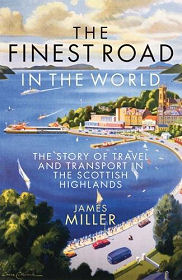 |
Today's visitor to Scotland finds a country with a pretty good transport system. With a few notable exceptions the roads are, by and large, capable of meeting the demands placed on them. The railway system is pretty good, and improving as lines closed in a less enlightened age are reopened. Ferry links are numerous and good; and air services help link places that would otherwise be hard to reach. You don't need to have known Scotland for all that long, however, to realise that today's picture is the result of rapid change over recent decades. We can remember when many of the main roads in the north and west were single track, for example; and when ferry services were fewer and further between, and often didn't run on Sundays.
If change has happened this quickly in recent times, what were things like before? How different was Scotland if you go back even further? "The Finest Road in the World: The Story of Travel and Transport in the Scottish Highlands" by James Miller is a superb book that sets out to answer these questions: and succeeds admirably.
The story that emerges is told partly thematically, and partly chronologically. We begin with an account of overland travel when most people travelled on foot; when only the wealthy few could afford to travel by horse; and when the state of what passed for tracks across much of Scotland meant that travel by carriage was not an option. The picture is painted through a blending of contemporary travellers' accounts and beautifully researched background. This is the approach the author adopts throughout and it works well. There's nothing quite like a traveller's own words for giving a sense of the experience of travel.
We then move on to look at drovers and drove roads; sailing in coastal waters; and the early postal service, often carried on foot. The story of the military roads is nicely and comprehensively told, as is that of the public roads and bridges that came later. Stagecoaches and toll roads come next, then maritime traffic, canals, fishing and smuggling, and the arrival of steam at sea. Railways, improved roads and tourists follow. The dawn of the modern era brings motor cars, and the need for still better roads, plus early air transport. The story continues into the modern era with the upgrading of the A9, exemplified by the building of the Kessock Bridge, and the demise of the postbus service. Even Calum's Road on Raasay gets a mention.
This is a book that should be read by anyone who's ever travelled Scotland and wondered how things have changed over the years, decades and centuries. It's certainly a book we know we'll want to refer to time and again.
InformationPaperback: 320 pagesBirlinn Ltd birlinn.co.uk 1 June 2017 Language: English ISBN-10: 1780274300 ISBN-13: 978-1780274300 Size: 23.3 x 2.7 x 15.6 cm Buy from Amazon (paid link) Visit Bookshop Main Page |
